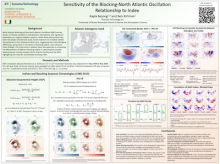Sensitivity of the blocking-North Atlantic Oscillation relationship to index
Kayla
Besong
University of Miami, Sonoma Technology Inc.
Poster
North Atlantic blocking and the North Atlantic Oscillation (NAO) are two phenomena that have been extensively studied due to their significant spatio-temporal overlap. This work presents an index comparison study applied to this relationship, bringing light to how the strength of it varies considerably depending on blocking index choice and why this could be leading to discrepancies found in previous works. A PV–θ blocking index is used alongside a direction of breaking metric to classify blocking as either cyclonic or anticyclonic based on the Rossby wave breaking occurring at onset. These results are compared against those found using an absolute geopotential height (AGP) index. The analysis is performed using both area-averaged blocking count during winter and at each grid-point across the North Atlantic for all seasons. The study demonstrates that the choice of method significantly affects the results when correlating wintertime blocking and NAO. Blocks found using the AGP index show a much stronger correlation with the NAO compared to those found with the PV–θ index. Other analyses, such as frequency, duration, and composites, suggest that the AGP algorithm detects stronger, more mature, and persistent blocks, which promote a higher correlation with the NAO compared to the shorter-lived PV–θ blocks. Based on this analysis, it can be concluded that different blocking events are being measured between the two indices, contributing to the stark differences in the correlation analysis, each with their own advantages and disadvantages in relating blocking to the NAO.

Poster file
besong-kayla-blocking-poster.pdf
(5.4 MB)
Meeting homepage
